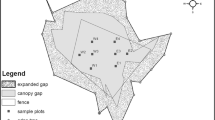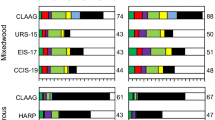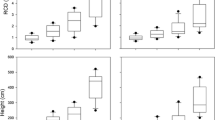Abstract
Previous studies have indicated that recruitment of Abies sachalinensis, a representative conifer species of northern Japan, decreased following single-tree selection harvesting in stands with dense dwarf bamboo understory. We tested the hypothesis that growth and survival of A. sachalinensis seedlings are reduced by canopy opening in that type of stand. A 0.75 ha study plot was examined, and all the seedlings (defined as trees with height 0.5–2 m) were identified and their shoot extensions measured for three years after single-tree selection harvesting (26% intensity in terms of basal area). The leader extensions of A. sachalinensis seedlings that experienced canopy opening were greatly improved. However, a negative effect on survival was also apparent; nearly 40% of seedlings died at the sites that experienced canopy opening. These results were supported by generalized linear models that examined variations of local harvesting intensity for individual seedlings. Despite the ability of A. sachalinensis to respond rapidly to exposure, some physiological stresses may have appeared, and presumably were amplified by co-occurring dwarf bamboos. With regard to the low seedling density (156 stems ha−1), common in this type of stands, local harvesting intensity in the selection system should be reduced to maintain survival of advanced regeneration, thus sustaining stand structure and composition.



Similar content being viewed by others
References
Bourgeois L, Messier C, Brais S (2004) Mountain maple and balsam fir early response to partial and clear-cut harvesting under aspen stands of northern Quebec. Can J For Res 34:2049–2059. doi:10.1139/x04-080
Claveau Y, Messier C, Comeau PG, Coates KD (2002) Growth and crown morphological responses of boreal conifer seedlings and saplings with contrasting shade tolerance to a gradient of light and height. Can J Res 32:458–468. doi:10.1139/x01-220
Duchesneau R, Lesage I, Messier C, Morin H (2001) Effects of light and intraspecific competition on growth and crown morphology of two size classes of understory balsam fir saplings. For Ecol Manage 140:215–225
Ferguson DE, Adams DL (1980) Response of advance grand fir regeneration to overstory harvesting in northern Idaho. For Sci 26:537–545
Franklin JF, Spies TA, Pelt RV, Carey AB, Thornburgh DA, Berg DR, Lindenmayer DB, Harmon ME, Keeton WS, Shaw DC, Bible K, Chen J (2002) Disturbances and structural development of natural forest ecosystems with silvicultural implications, using Douglas-fir forests as an example. For Ecol Manage 155:399–423
Harada A, Yoshida T, Resco de Dios V, Noguchi M, Kawahara T (2008) Growth and survival of tall tree seedlings 6–8 years after soil scarification in Hokkaido (in Japanese with English summary). J Jpn For Soc 90:297–305. doi:10.4005/jjfs.90.397
Hosaka T, Owari T, Goto S (2008) Relationships between the distribution and site conditions of Abies sachalinensis seedlings, saplings and juveniles in selection cutting stands of natural forests in central Hokkaido, Japan (in Japanese with English summary). J Jpn For Soc 90:357–363. doi:10.4005/jjfs.90.357
Ishibashi S (1998) The relationship between natural regeneration and land/forest description in natural cool-temperate and boreal forests (in Japanese with English summary). J Jpn For Soc 80:74–79
Kawahara T, Suzuki T (1981) Studies on Sasa communities. 4. Biomass of Sasa kurilensis and Sasa paniculata communities. J Jpn For Soc 63:173–178 (in Japanese)
Kneeshaw DD, Bergeron Y, De Grandprè L (1998) Early response of Abies balsamea seedlings to artificially created openings. J Veg Sci 9:543–550. doi:10.2307/3237270
Kneeshaw DD, Williams H, Nikinmaa E, Messier C (2002) Patterns of above- and below-ground response of understory conifer release 6 years after partial cutting. Can J For Res 32:255–265. doi:10.1139/x01-190
Kubota Y, Konno Y, Hiura T (1994) Stand structure and growth patterns of understory trees in a coniferous forest, Taisetsuzan National Park, northern Japan. Ecol Res 9:333–341. doi:10.1007/BF02348420
Matsuda K, Shibuya M, Koike T (2002) Maintenance and rehabilitation of the mixed conifer-broadleaved forests in Hokkaido, northern Japan. Eurasian J For Res 5:119–130
Messier C, Doucet R, Ruel JC, Claveau Y, Kelly C, Lechowicz MJ (1999) Functional ecology of advance regeneration in relation to light in boreal forests. Can J For Res 29:812–823. doi:10.1139/cjfr-29-6-812
Nagaike T, Kubota Y, Watanabe N (1999) The effects of selective logging on stand structure and the regeneration of subboreal forests in Hokkaido, northern Japan. J For Res 4:41–45. doi:10.1007/BF02760323
Nagel TA, Svoboda M, Diaci J (2006) Regeneration patterns after intermediate wind disturbance in an old-growth Fagus–Abies forest in southeastern Slovenia. For Ecol Manage 226:268–278
Nakagawa M, Kurahashi A (2005) Factors affecting soil-based natural regeneration of Abies sachalinensis following timber harvesting in a sub-boreal forest in Japan. New For 29:199–205. doi:10.1007/s11056-005-0273-5
Noguchi M, Yoshida T (2004) Tree regeneration in partially cut conifer-hardwood mixed forests in northern Japan: roles of establishment substrate and dwarf bamboo. For Ecol Manage 190:335–344
Noguchi M, Yoshida T (2005) Factors influencing the distribution of two co-occurring dwarf bamboo species (Sasa kurilensis and Sasa senanensis) in a conifer-broadleaved mixed stand in northern Hokkaido. Ecol Res 120:25–30. doi:10.1007/s11284-004-0009-6
Noguchi M, Yoshida T (2007) Regeneration responses influenced by single tree selection harvesting in a mixed-species tree community in northern Japan. Can J For Res 37:1554–1562. doi:10.1139/X07-103
Noguchi M, Yoshida T (2009) Individual-scale responses of five dominant tree species to single tree selection harvesting in a mixed forest in Hokkaido, northern Japan. J For Res (in press)
Noguchi M, Kayama M, Yoshida T, Koike T (2003) Photosynthetic traits of seedling of Sakhalin fir grown on the selective cutting forest (in Japanese). Trans Meet Hokkaido Branch Jpn For Soc 51:36–38
R Development Core Team (2008) R: a language and environment for statistical computing. R Foundation for Statistical Computing, Vienna. ISBN 3-900051-07-0. http://www.R-project.org
Schütz JP (2002) Silvicultural tools to develop irregular and diverse forest structures. Forestry 75:329–337. doi:10.1093/forestry/75.4.329
Stancioiu PT, O’Hara KL (2006) Morphological plasticity of regeneration subject to different levels of canopy cover in mixed-species, multiaged forests of the Romanian Carpathians. Trees (Berl) 20:196–209. doi:10.1007/s00468-005-0026-2
Takahashi K, Uemura S, Suzuki J, Hara T (2003) Effects of understory dwarf bamboo on soil water and the growth of overstory trees in a dense secondary Betula ermanii forest, northern Japan. Ecol Res 18:767–774. doi:10.1007/s11284-003-0594-9
Tatewaki M (1958) Forest ecology of the islands of the north Pacific Ocean. J Fac Agric Hokkaido Univ 50:371–486
Tucker GF, Hinckley TM, Leverenz JW, Jiang SM (1987) Adjustments of foliar morphology in the acclimation of understory Pacific Silver fir following clearcutting. For Ecol Manage 21:249–268
Wang JR, Letchford T, Comeau PG, Coopersmith D (2000) Foliar responses of understorey Abies lasiocarpa to different degrees of release cutting in a Betula papyrifera and conifer mixed species stand. Scand J For Res 15:611–620. doi:10.1080/02827580050216860
Wright EF, Canham CD, Coates KD (2000) Effects of suppression and release on sapling growth for 11 tree species of northern, interior British Columbia. Can J For Res 30:1571–1580. doi:10.1139/cjfr-30-10-1571
Yajima T, Watanabe N, Shibuya M (1997) Changes in biomass of above-and under-ground parts in Sasa kurilensis and Sasa senanensis stands with culm height (in Japanese with English summary). J Jpn For Sci 79:234–238
Yoshida T, Iga Y, Ozawa M, Noguchi M, Shibata H (2005) Factors influencing early vegetation establishment following soil-scarification in a mixed forest in northern Japan. Can J For Res 35:175–188. doi:10.1139/x04-156
Yoshida T, Noguchi M, Akibayashi Y, Noda M, Kadomatsu M, Sasa K (2006) Twenty years of community dynamics in a mixed conifer-broadleaved forest under a selection system in northern Japan. Can J For Res 36:1363–1375. doi:10.1139/X06-041
Acknowledgments
We are grateful to anonymous reviewers for helpful comments. We thank the staff of the Uryu Experimental Forest for their assistance in establishing the study plot. Thanks are also extended to Yoko Iga, Mio Nagai, and the members of the Research Group of the Boreal Forest Conservation, Hokkaido University for their assistance in the fieldwork. This research was partially funded by the Ministry of Education, Culture, Sports, Science, and Technology of Japan (No. 17580123) and a Sasakawa Scientific Research Grant from the Japan Science Society. We declare that all the experiments complied with the current Japanese laws.
Author information
Authors and Affiliations
Corresponding author
Rights and permissions
About this article
Cite this article
Yoshida, T., Noguchi, M. Growth and survival of Abies sachalinensis seedlings for three years after selection harvesting in northern Hokkaido, Japan. Landscape Ecol Eng 6, 37–42 (2010). https://doi.org/10.1007/s11355-009-0080-9
Received:
Revised:
Accepted:
Published:
Issue Date:
DOI: https://doi.org/10.1007/s11355-009-0080-9




